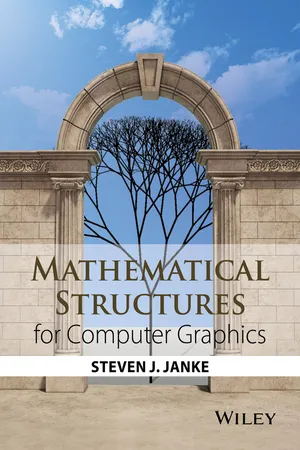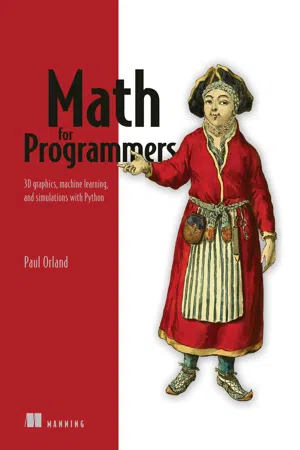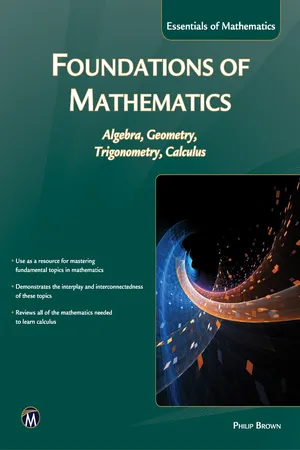Mathematics
Equation of Line in 3D
The equation of a line in 3D is represented by a vector equation or parametric equations. The vector equation involves a point on the line and a direction vector, while the parametric equations involve three equations that represent the x, y, and z coordinates of points on the line in terms of a parameter t.
Written by Perlego with AI-assistance
Related key terms
4 Key excerpts on "Equation of Line in 3D"
- eBook - ePub
- Steven J. Janke(Author)
- 2014(Publication Date)
- Wiley(Publisher)
Analytic geometry takes the Cartesian coordinates of the points and produces a more complete description. Assuming the line is two dimensional and the coordinates are and, then the point-slope form of the line yields This description gives the coordinates for all the points on the line and hence is more useful when having to plot pixels on the display screen. A version of the line equation,, gives what we call an implicit description of the line, because it does not explicitly describe how to calculate one coordinate from another (although a little algebra is all that is needed). There is not a single implicit equation for three-dimensional lines, so we turn to vector descriptions which generalize easily. For two-dimensional lines, the vector description is simple. First, calculate the vector. The direction of this vector is parallel to the line and any multiple,, is also parallel. We call the direction vector for the line. Starting at point and adding the direction vector gives us a point,, on the line. If, then the point is on the line segment between and ; for, we get and for, we get. For values of the parameter that are larger than 1 or less than 0, the points are on the extension of the line segment. If is an arbitrary point on the line, we can write 3.1 We can split this parametric description into two coordinate equations. If we let, then using the coordinates of, we have Solving for in the first equation and substituting in the second gives the implicit form we saw before,. In the parametric descriptions, is the multiplier for and tells us where we are on the line. The implicit line equation, on the other hand, does not directly describe relative locations on the line. Instead, the ratio of the coefficients for and in the implicit equation gives the slope of the line. Still thinking in terms of vectors, the direction vector is, of course, parallel to the line and therefore is perpendicular to the line because - eBook - ePub
Math for Programmers
3D graphics, machine learning, and simulations with Python
- Paul Orland(Author)
- 2020(Publication Date)
- Manning(Publisher)
For instance, if two lines are parallel, they can have either no intersection points or infinitely many (which would mean they are the same line). This means there is no (x, y) value that simultaneously satisfies both lines’ equations. A matrix representing such a system is called singular. Planes in 3D are the analogs of lines in 2D. They are the sets of points (x, y, z) satisfying equations of the form ax + by + cz = d. Two non-parallel planes in 3D intersect at infinitely many points, and specifically, the set of points they share form a 1D line in 3D. Three planes can have a unique point of intersection that can be found by solving the system of three linear equations representing the planes. Lines in 2D and planes in 3D are both cases of hyperplanes, sets of points in n -dimensions that are solutions to a single linear equation. In n -dimensions, you need a system of at least n linear equations to find a unique solution. If you have exactly n linear equations and they have a unique solution, those are called independent equations. Figuring out how to write a vector as a linear combination of a given set of vectors is computationally equivalent to solving a system of linear equations. If the set of vectors is a basis for the space, this is always possible. - eBook - ePub
Foundations of Mathematics
Algebra, Geometry, Trigonometry and Calculus
- Philip Brown(Author)
- 2016(Publication Date)
- Mercury Learning and Information(Publisher)
section 2.6 ).The mathematical methods in a two-dimensional coordinate system that we introduce in this chapter can be generalized to a three-dimensional coordinate system (although we will not do it in this book). A three-dimensional coordinate system can be used as a mathematical representation of the three-dimensional physical space in which we humans move around; and it is in this coordinate representation of three-dimensional space that mathematicians and scientists can carry out advanced mathematical simulations of dynamic processes like ocean currents, planetary weather patterns, motions of projectiles, and exploding stars.2.2WORKING IN A COORDINATE SYSTEM
Any given point in the Cartesian plane can be labeled by means of two numbers called coordinates. The first coordinate is called the x-coordinate, and the second is called the y-coordinate. The x- and y-coordinates together form a coordinate pair. The x-coordinate can be found by following a vertical line from the given point to a point on the x-axis and reading its position on the number line. Similarly, the y-coordinate can be found by following a horizontal line from the given point to a point on the y-axis and reading its position on the number line. Points in the Cartesian plane are usually labeled using uppercase letters with the coordinate values following in parentheses, as shown in figure 2.2 . The axes separate the Cartesian plane into four quadrants (first, second, third, and fourth quadrants) that can be labeled as I, II, III, and IV, respectively, in a counterclockwise order, starting with the upper right quadrant.FIGURE 2.2. Points in the Cartesian plane.2.3LINEAR EQUATIONS AND STRAIGHT LINES
Much of mathematics involves the study of related quantities in the form of equations. For this reason, we begin with a study of linear equations and the graphs (infinite straight lines) of linear equations in the Cartesian plane because these quantify the simplest kind of relationship (linear) that related quantities can have. We will refer to an “infinite straight line” (in the Cartesian plane) as a “line.” - eBook - ePub
- Dan Pedoe(Author)
- 2013(Publication Date)
- Dover Publications(Publisher)
IVTHE REPRESENTATION OF CIRCLES BY POINTS IN SPACE OF THREE DIMENSIONSThe equation of a circle in normalized form depends on three parameters, and it is natural to enquire whether there is a useful mapping of circles onto the points of Euclidean space of three dimensions. We give such a mapping, and we shall see that this leads to valuable geometric insights into the geometry of circles. We begin, however, with a rapid survey of the few simple geometrical properties of E3 , Euclidean space of three dimensions, which we wish to use. Because of the possibility of extension to Euclidean and affine space of n dimensions, we use coordinates (X1 , X2 , X3 ) here instead of (X, Y, Z), but in §36.1 we shall return to (X, Y, Z) coordinates.Fig. 33.1 33.1 Vectors in Euclidean and affine space of three dimensionsLet P = (x1 , x2 , x3 ) and Q = (y1 , y2 , y3 ) be two points in Euclidean or affine space of three dimensions, where the coordinates are taken with reference to a given system of Cartesian coordinates, origin O (Fig. 33.1 ). Then the directed segment or vector is defined to be the ordered triad of real numbersTwo vectors and are thought of as being equivalent when PQ is parallel to RS, when the length of PQ = length of RS, and when the direction of motion from P to Q is the same as that from R to S. All this is expressed thus: if R = (z1 , z2 , z3 ), and S = (t1 , t2 , t3 ), then if and only if the ordered triad of real numbers defining is the same as the ordered triad (t1 – z1 , t2 – z2 , t3 – z3 ) which defines .The fact that this definition does define an equivalence relation is immediately verified. As in §1.1 , there is always one representative of an equivalence class of vectors with its first number triad at (0, 0, 0). Vectors issuing from the origin will be called bound vectors, and these are representative of free vectors, which do not necessarily issue from (0, 0, 0). (Fig. 33.2. )Fig. 33.2 Fig. 33.3
Index pages curate the most relevant extracts from our library of academic textbooks. They’ve been created using an in-house natural language model (NLM), each adding context and meaning to key research topics.



